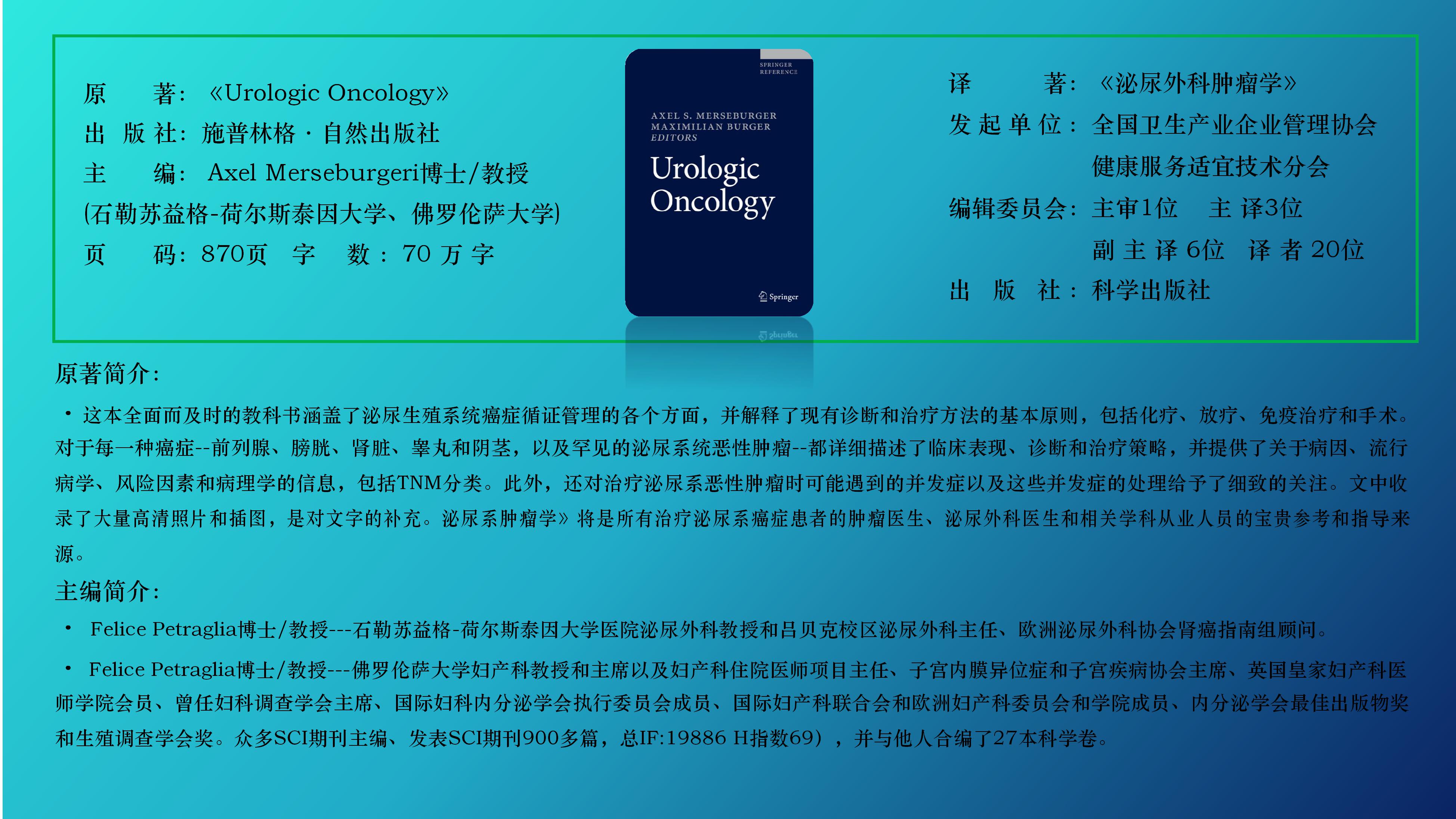系列丛书
当前位置:首页 > 系列丛书

原著:《Urologic Oncology》
译 著:《泌尿外科肿瘤学》
This comprehensive and timely textbook covers all aspects of the evidence-based management of genitourinary cancers and explains the fundamental principles underlying the available diagnostic and treatment approaches, including chemotherapy, radiotherapy, immunotherapy, and surgery. For each type of cancer – prostate, bladder, renal, testicular, and penile, plus rare urologic malignancies – clinical presentation, diagnosis, and treatment strategies are described in detail and information is provided on etiology, epidemiology, risk factors, and pathology, including TNM classification. Careful attention is also devoted to the complications that may be encountered when treating urologic malignancies and to the management of these complications. The text is complemented by the inclusion of numerous high-definition photographs and illustrations. Urologic Oncology will be a valuable reference and source of guidance for all oncologists, urologists and practitioners in related disciplines who treat patients with urologic cancers.
0. Front Matter
1. Introduction
1.1 Front Matter
1.2 Molecular Basics on Genitourinary Malignancies
1.3 Clinical Aspects and Investigations in Genitourinary Cancer
1.4 Clinical Trials and Their Principles in Urologic Oncology
1.5 Bone Target Therapy in Urologic Malignancies
2. Prostate Cancer
2.1 Front Matter
2.2 Screening of Prostate Cancer
2.3 Risk Assessment Based on Molecular and Genetic Markers in Prostate Cancer
2.4 Local and Systemic Staging by Modern Imaging Modalities in Prostate Cancer
2.5 Prostate Cancer Biopsy: Strategies
2.6 Pathological Assessment of Prostate Cancer
2.7 Natural History of Untreated Localized Prostate Cancer: Rational for Active Surveillance
2.8 Surgical Management of Localized and Locally Advanced Prostate Cancer
2.9 Radiotherapy for Localized and Locally Advanced Prostate Cancer
2.10 Management of Nonmetastatic Failure Following Local Prostate Cancer Therapy
2.11 Systemic Treatment of Castration-Resistant Metastatic Prostate Cancer
2.12 Androgen Deprivation Therapy for Advanced Prostate Cancer
2.13 Management of Metastatic Castration-Naïve Prostate Cancer
3. Bladder Cancer
3.1 Front Matter
3.2 Epidemiology and Sociocultural Differences for Bladder Cancer
3.3 Symptoms and Diagnostic Tools for Bladder Cancer
3.4 Transurethral Resection of Bladder Cancer and Its Applications
3.5 How Endoscopy Founded Modern Urology
3.6 Early-Invasive Urothelial Bladder Carcinoma and Instillation Treatment of Non-muscle-Invasive Bladder Cancer
3.7 Urothelial Carcinoma In Situ and Treatment of Bacillus Calmette-Guérin Failures
3.8 Local Treatment, Radical Cystectomy, and Urinary Diversion
3.9 Multimodality Treatment for Bladder Conservation
3.10 Peri-operative Chemotherapy for Muscle-Invasive Bladder Cancer
3.11 Metastatic Bladder Cancer Disease and Its Treatment
3.12 Rare Subentities of Urothelial Bladder Carcinoma
3.13 Risk Stratification and Prognostication of Bladder Cancer
3.14 Qualified Rehabilitation After Radical Treatment for Bladder Cancer
3.15 Follow-Up of Bladder Cancer
4. Renal Cancer
4.1 Front Matter
4.2 Epidemiology of Renal Cell Carcinoma and Its Predisposing Risk Factors
4.3 Symptoms of Kidney Cancer and Appropriate Diagnostic Tools
4.4 Prognostic and Predictive Markers, and Stratifications Tables, for the Detection and Treatment of Renal Cell Carcinoma
4.5 Molecular Heterogeneity of Renal Cell Carcinoma
4.6 Histological (Sub)Classifications and Their Prognostic Impact in Renal Cell Carcinoma
4.7 Treatment of Small Renal Masses
4.8 Partial Versus Total Nephrectomy: Indications, Limitations, and Advantages
4.9 Surgical Methods in Treatment of Kidney Tumors: Open Surgery Versus Laparoscopy Versus Robotic Surgery
4.10 Systemic and Sequential Therapy in Advanced Renal Cell Carcinoma
4.11 Metastatic Surgery in Advanced Renal Cell Carcinoma
4.12 Advisable Follow-Up for Kidney Tumors
5. Testicular Cancer
5.1 Front Matter
5.2 Epidemiology, Risk Factors, and Histopathology in Testicular Cancer
5.3 Symptoms, Diagnosis, and Staging in Testicular Cancer
5.4 Treatment of Local Disease in Testicular Cancer
5.5 Management of Germ Cell Neoplasia In Situ (GCNIS)
5.6 Management of Clinical Stage I (CSI) Disease in Testicular Cancer
5.7 Treatment of Clinical Stage II (CS II) Disease in Testicular Cancer
5.8 Stage III Germ Cell Cancer
5.9 Management of Residual Tumor in Testicular Cancer
5.10 Postchemotherapy Retroperitoneal Lymph Node Dissection in Advanced Germ Cell Tumors of the Testis
5.11 Follow-Up for Testicular Cancer
6. Other Rare Urologic Malignancies (Non-urological Cancers Affecting the Urinary Tract)
6.1 Front Matter
6.2 Urethral Carcinoma
6.3 Adrenal Tumors
6.4 Retroperitoneal Tumors in Adults
6.5 Urologic Tumors in Childhood: Nephroblastoma and Wilms Tumor
7. Penile Cancer
7.1 Front Matter
7.2 Epidemiology and Histopathology: Penile Cancer
7.3 Advanced Disease and Recurrent Disease in Penile Cancer
7.4 Diagnosis and Staging in Penile Cancer
7.5 Treatment of the Primary Tumor: Role of Organ-Preserving Surgery in Penile Cancer
7.6 Lymph Node Management in Penile Cancer
7.7 Role of Neoadjuvant and Adjuvant Chemotherapy in Penile Cancer
8.Back Matter

